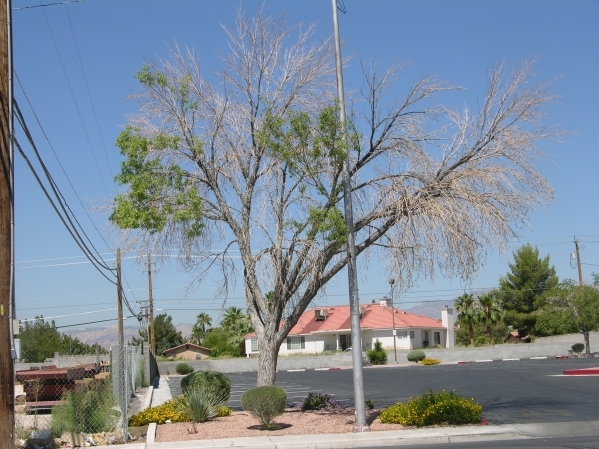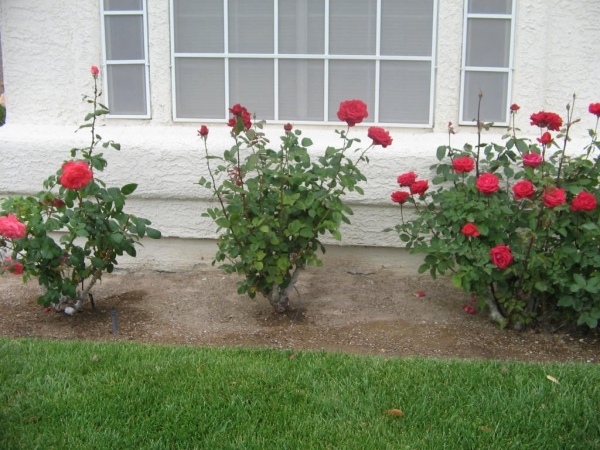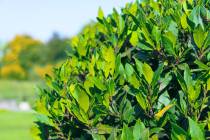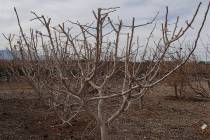Roses grow well in desert climate of Southern Nevada
Q: I enjoy your column, but you never write about roses. We inherited 14-year-old bushes. The bushes are important, and they should look nice.
A: Roses do extremely well in the desert. The "winter" for them here is the summer months. Expect roses to look worse in the summer. The rest of the year they do beautifully and can be prolific bloomers. If you want roses to bloom during late December and January, put them in a warm microclimate that throws out radiant heat during the winter.
Roses prefer organic soils, not mineral soils. Always plant roses in soils amended with compost and mulch the soil surface with wood chips or other organic mulch that decomposes. If you must use bark mulch, apply it to the top of a wood chip mulch.
Always plant into a "wet" hole, never directly into a dry soil or soil mix.
Roses, once established, can get by on a single application of fertilizer each year. However, roses perform better when fertilized more often. For best results, fertilize roses frequently with small amounts of fertilizer, perhaps every four to eight weeks. Until you find your favorite rose fertilizer, use an established brand name labeled for roses.
Substitute foliar applications instead of applying fertilizer to the soil, but apply these more often. Roses will develop yellow leaves growing in our soils. Apply an iron chelate to the soil in January to avoid this problem. Always avoid nitrogen fertilizers in any form during the heat of the summer.
Roses do extremely well with drip irrigation and wood chip mulch. Avoid using sprinklers that wet the foliage for irrigation. This causes white salt deposits on the leaves and may promote powdery mildew. Apply water just like you would any other small- to medium-sized shrub.
Major pruning is done in late December to early January. Light pruning can be done at any time. Light prune new growth only, such as suckers and growth that is vertical.
Another form of pruning is deadheading. Deadheading is removing old, spent flowers when they are no longer pretty. That helps encourage more flowers and improves the look of the plants. Remove these flowers any time they are finished.
Insects and diseases are not terribly common in our desert climate. However, they do occur. Be on the lookout for aphids, flower thrips, spider mites, leaf cutter bee and cane borer. Treat for them, or not treat for them, accordingly.
Q: We removed half of our lawn that had a 15-year-old Chilean mesquite in the middle. It had done very well up to this point. During grass removal, roots were chopped, and six small plants with drip emitters were installed in the rock mulch surrounding the tree. Will the tree be OK?
A: The short answer is it will not be OK. Supply more water to this tree than the six shrubs are receiving, or the mesquite will drop its leaves, and the branches will die back.
Now the long answer. A mesquite can develop a very deep root system when growing in the wild along arroyos, 200 feet deep or more. Arroyos, or desert gullies, concentrate rainwater in one location, pushing water to great depths with the roots following not far behind.
Mesquite planted in a lawn will grow vigorously with a very dense canopy. It does not develop deep roots because the water from a lawn penetrates only the surface a few inches. A few feet beneath the lawn, it is dry.
During 15 years of growth, the mesquite will have a mesh of roots spider-webbing just below the lawn. The six irrigated plants under the canopy help somewhat but not enough. My hunch is your mesquite will start dropping leaves, and limbs will die.
What should you do? You should put a hose out there and flood the rock beneath the tree about once a week during hot weather. That is a stopgap measure until you can do something more permanent.
Consider installing a "bubbler and basin" around the tree to provide more water. Install an irrigation bubbler 2 feet from the trunk. If this basin is quite large, two bubblers might be needed. Each time you irrigate, fill the basin.
The bottom of the basin must be level and wide enough to cover half of the area under the tree canopy. The basin should be 3 to 4 inches high with the trunk at its center.
The bubbler is a type of emitter that can deliver 1 to 2 gallons a minute. Drip emitters deliver gallons of water in hours, not minutes. Bubblers deliver a large amount of water in one area in a very short time period. That is why a flat basin is needed.
If the tree is on a slope, install the basin around the trees and make sure it is level. The water from the bubbler must be contained by the basin for this method to work. It will take bubblers 10 to 15 minutes to deliver enough water to fill a basin.
In midsummer when it's hot, water once a week to every 10 days for desert trees like mesquite. Adjusting how often water is applied and how much will determine how fast the tree grows and the density of the canopy.
If you water less often, but apply more water each time, you will slowly encourage the roots of desert trees like mesquite to grow deeper.
Q: What is the best way to remove mature salt cedar and the seedlings that are sprouting all over the yard?
A: You have some work cut out for you. Once you kill the tree, the roots will start to sucker all over the place. This tree produces thousands of seeds every year. You will see tiny seedlings popping up from the soil for several years to come.
Salt cedar is a problem tree because it uses vast amounts of water and kills other plants growing close to it. It kills or stops plants from growing close by pulling salt out of the soil with its roots, concentrates this salt inside its needlelike foliage and then drops it on top of the soil. This salt concentration on the soil surface acts just like a weed killer or herbicide.
This tree also suckers easily from its roots. Salt cedar evolved in locations where there were lots of fire. Sprouting or suckering from the roots after a fire ensures its future survival. Just like a fire, you are eliminating the mother plant that releases new growth from roots.
The most effective way to remove this tree is to cut it as close to the soil as possible and apply "weed killers" to the fresh surface of the cut while it is a still fresh, open wound.
Another method is to drill holes in the trunk as low as possible — close to the soil — and inject weed killer into these fresh wounds. The label will tell you the concentration you should use for these treatments.
Timing is important. The best time is in the fall months just before plants are preparing for winter, not the spring. In our climate, this would be October and perhaps early November.
After the tree has been injected and starts to die, you probably will see suckers growing from the roots in a last-ditch effort to stay alive. Cut these suckers close to the ground and daub on the fresh cut ends with the same solution.
Small, new plants growing from seed are easier to kill. Use the same chemicals but apply them as soon as seedlings emerge. Do not wait for them to get established. Always use a wetting agent or detergent when spraying the foliage of plants.
Do not make the mistake of thinking that a greater concentration of chemicals give a better kill. Use the dilutions mentioned in the label. These were established by the manufacturer and tested in the field for good results.
— Bob Morris is a horticulture expert living in Las Vegas and professor emeritus for the University of Nevada. Visit his blog at xtremehorticulture.blogspot.com. Send questions to Extremehort@aol.com.


























